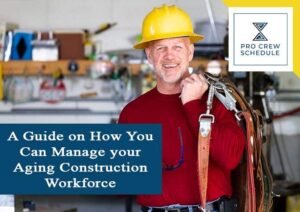The median age for a construction worker is forty-three years old. Hence, roughly forty percent of all workers in the industry are aged between 45 and 64. It only shows that the number of senior workers is rising while the number of young workers is decreasing. Having an aging and experienced workforce provides you significant advantages because older ones are much safer in executing activities and have a proven track record.
However, given the projected “aging workforce” in your company, how well are you preparing to address some issues and conflicts associated with your current workforce? In this blog, let’s tackle about aging workforce in construction, including the best practices that can help you manage them while having them in your company.
Why Construction Cannot Afford to Lose Aging Workforce?
To answer the question directly – the industry is facing a serious skill shortage. And with the working population continues to age, it is important to determine how to help retain the knowledge of the aging workforce and encourage them to work longer with the company.
In construction, everyone almost hanged up their hi-vis vests and retire by the age of sixty-five. However, the industry can no longer afford to let this happen instantly. Suppose the construction industry is truly diverse and can cater to everybody. In that case, it can’t stop at ethnicity, gender and age diversity because the latter is just as important with other types of diversity.
There are considerable advantages associated with having an aging workforce in the company:
- Older workers are more engaged at work compare to young ones.
- They have a higher level of professionalism and maturity.
- They have more excellent work ethic.
- They’re stable and hardworking, resulting in reduced turnover.
- They possessed knowledge and work experience that offsets cognitive declines.
Furthermore, it’s important to value and recognize the wisdom and knowledge of older employees and harness them constantly in the future. But take note that the need to harness the experiences of the aging workforce presents a twofold challenge in construction:
- First, how to ensure that they continue to feel fulfilled and happy with their working environment?
- Second, how to capture their years of experiences and insights before they will finally retire?
Five Best Practices in Managing Your Aging Workforce
To best manage your aging workforce, here are the best practices you can apply to address your old workers’ special needs and further enhance workplace safety.
1. Employee Health and Fitness
A fit and healthy workforce promotes a safer workforce. In fact, there’s a direct correlation between fitness and health, including how well the human body can prevent any injuries and heal. The most significant injuries usually occur to older crews involve sprains and strains to the necks, shoulders, knees, and backs. Most of these injuries are cumulative trauma disorders commonly caused by a lack of flexibility and strength. The management has to educate employees regarding the critical role both strength and flexibility play in preserving fitness.
And establishing good health, there has to be a continuous emphasis on the importance of personal responsibility. Wellness programs, for instance, can significantly reduce any risk factors for injuries. The workplace can be the ideal location for warm-up programs since it offers the structure and routine needed in the best of circumstances, contributing to a positive culture. Preferably, stretching programs have to be completed at the start of each daily shift. It will then be a major part of the safety routine for your employees.
2. Reducing Physical Demands
Construction-related work can be repetitive and strenuous. However, an employer like you has to be fair and sensitive in limiting specific physical activities that may lead to a high risk of injury on your aging workers. The project manager has to know their workforce and should be aware of the physical restrictions that some old crews may have. Likewise, old workers have to know their limitations as well.
If there are tasks that can no longer be safe for them to execute, they have to communicate with the project manager directly. It is also essential they consider some job accommodations to protect themselves and their coworkers further. Using subcontractor scheduling software, communicating with other crew members is more accessible and convenient.
In reality, decades of vigorous work on-site will take a toll on anyone. By the age of 50, a worker’s body will become more and more susceptible to cumulative trauma disorders. It may also be more challenging, especially for aging workers, to fully recover from cumulative trauma injuries.
Below are some sensible measures that you can take to significantly reduce the potential for injuries, especially to aging workers:
- Reduce stooping, squatting, and kneeling activities.
- Keep workers from working above-the-shoulder jobs as much as possible.
- Rotate job tasks and processes. Schedule accordingly using construction scheduling software.
- Reduce highly vigorous activities on crew members such as pulling, twisting and lifting.
- Focus more on eliminating trip, slip and fall exposures.
- Provide assistive devices like dollies, hand trucks, and hoists for material handling.
There has to be constant open communication between the older workers and the management to build clear expectations. Both involved parties have to work together to ensure that the old workers can perform the job safely and carefully within their physical abilities. This is why project managers must establish measurable goals, understand worker’s strengths and limitations, and complete worker performance reviews.
3. Project Manager Accountability
Successful management for your aging workforce can be entirely determined by supervision. In order for all safety programs to be successful, project managers should be involved and held accountable. Project managers have the most influence in altering employee behaviors and encouraging them to get involved in the safety process. Deploying fitness programs and making changes to long-practiced at-risk behaviors will never come without any challenges.
Here are some highly suggested topics for advanced management training which help project managers improve their abilities as a mentor and a leader:
- Establishing credibility
- Building rapport with the workforce
- Construction crew management
- Earning respect
- Team building
- Goal setting
- Soliciting employee suggestions for further improvement
- Providing positive recognition and constructive feedback
- Fundamentals of leading group training
And unless it is all applied on the job, training has no value. For company owners to successfully integrate manager leadership and safety, the project manager must be audited to apply what they have learned.
4. Ergonomics
A contractor like you has the opportunity to align ergonomic benefits with the aging workforce. It is important that contractors check that these programs assess work-rest cycles and fatigue, while the pace of work and the capacity to keep up has been an issue lately. It is also crucial that you evaluate construction tools, work instructions and signage for aging workers. For some reason, older workers have a more challenging time seeing and reading printed instructions. If this is the case, building construction software for small builders will be a great advantage. Old crew members will only have to bring their phones or tablets and open the app. And from there, they can check important announcements, additional instructions, updates, etc.
Moreover, age-specific evaluations must be used to fit the job to the worker and not the other way around. In many cases, motion and time studies can be used for particular repetitive tasks to help minimize motion and, in return, fatigue. Strength capabilities, repetition rates, compression rates must be measured and benchmarked, particularly for older workers with biomechanical and epidemiological modifiers.
5. Make Use of Construction Management Software for Builders and Contractors
Deploying specialized software tools is one great way to boost performance and productivity in your projects and enhance safety for the aging workforce. While the young generation of workers is way more skilled using modern technologies, aging workers are more patient and, thus, can be better at this area over time. When used correctly, such software tools can eliminate expensive reworks and human errors.
This state-of-the-art scheduling software comes with scheduling features that can help a project manager like you to realign crew shifts based on worker training, availability, and of course, age. Construction activities are physically demanding. This type of project enforces specific safety and health regulations for your aging workers, like minimum rest periods for crew members between shifts. This is the perfect time to use the scheduling tool to sort out shift requirements without entirely affecting workers’ well-being and health and overall project performance.
This software tool with advanced features allows you to schedule applicable safety rules and training evaluations. It will be also easier for you to evaluate the success of the training by simply monitoring your old workers in the field using this specialized software solution. Your top priority is to make sure that they perform the tasks safely, equipped with the right PPEs.
Request a demo now to learn more about Pro Crew Schedule.
Key Takeaways
For company owners, contractors, and project managers, any initiatives to understand, assess, and supervise the impact of an aging workforce on productivity and costs have to start with leadership engagement and obtaining support. Such strong efforts call for closer collaboration among those within the company and any third-party providers accountable for employee benefits and wellness, risk management, etc.







